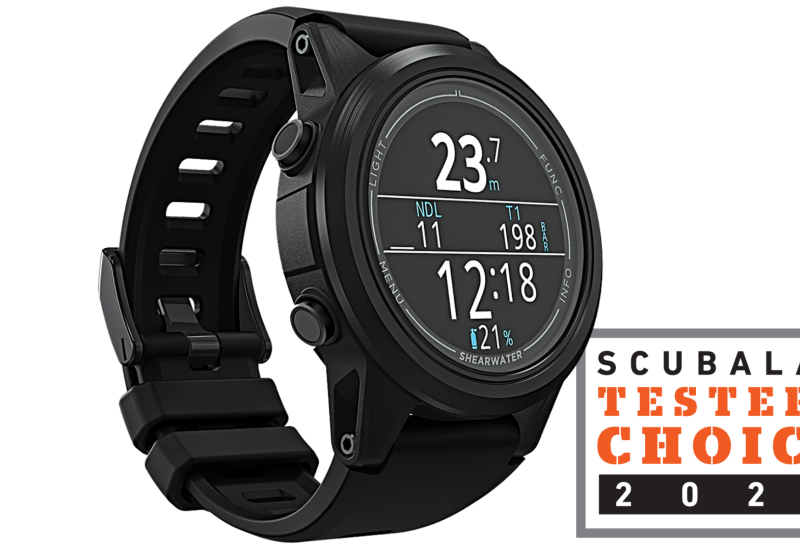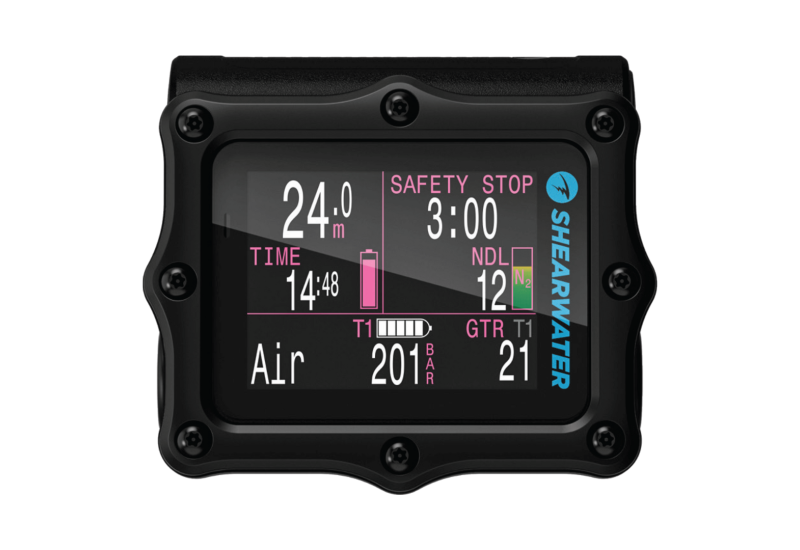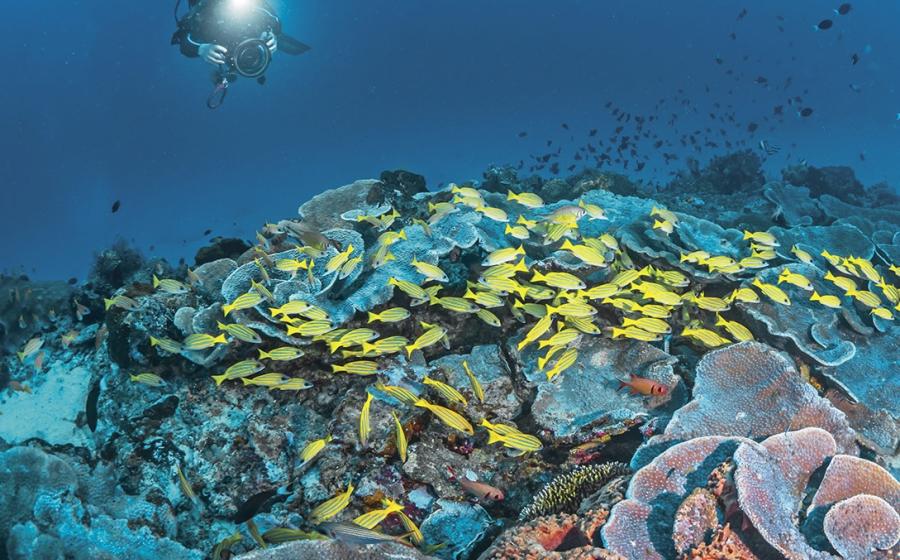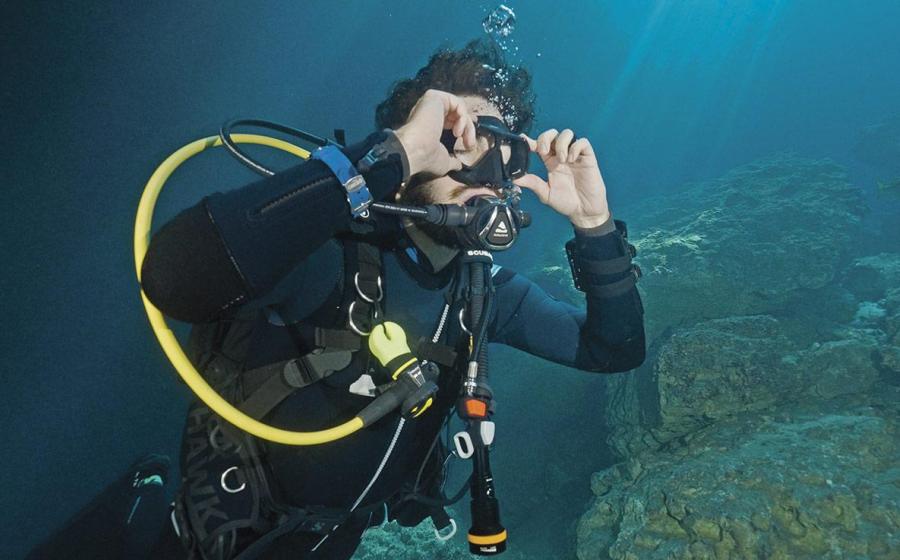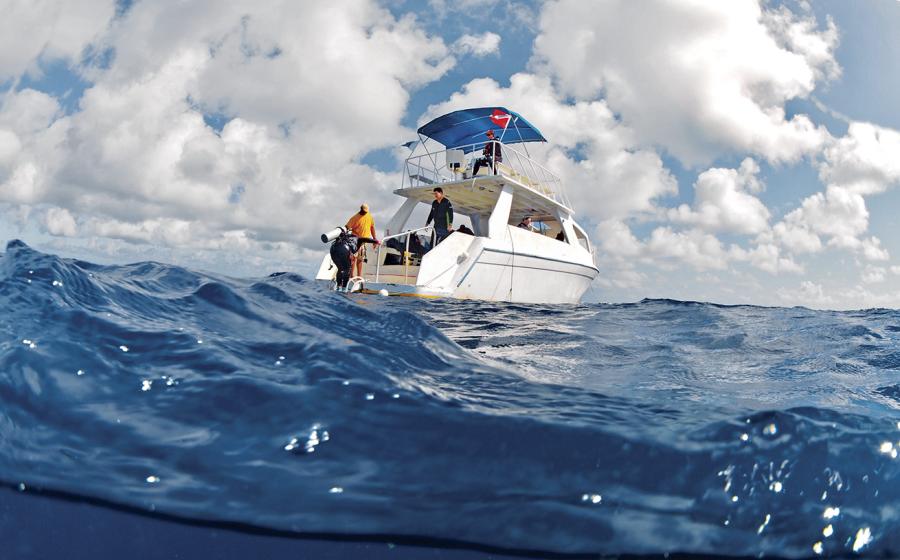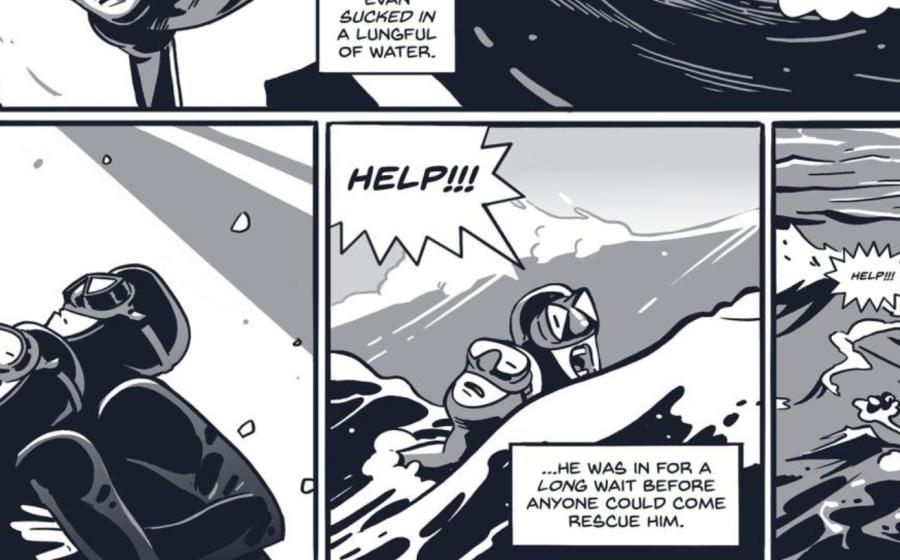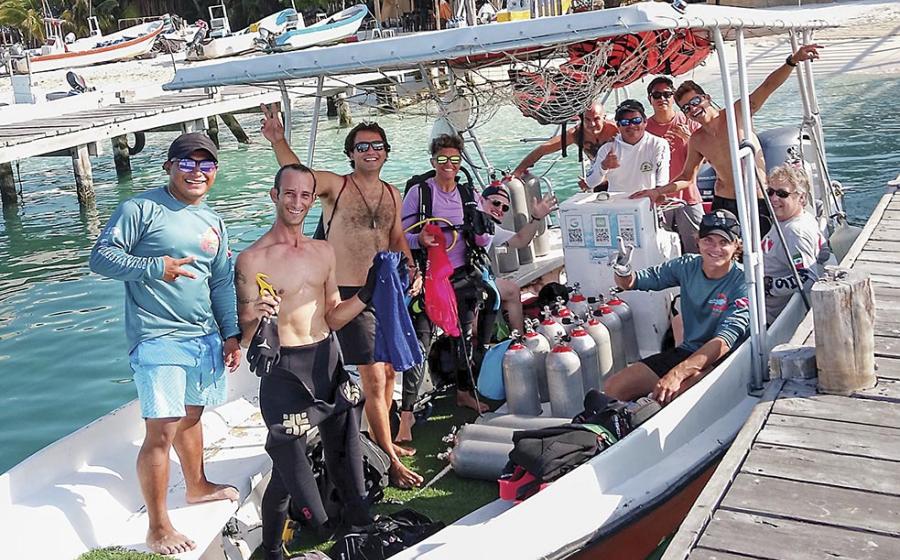14 New Dive Computers
January 2003
By John Brumm
Computers Reviewed in This Article
AERIS Atmos 1 AERIS Atmos 2 AERIS Atmos ai CRESSI-SUB Archimede DACOR Darwin MARES M1 OCEANIC Versa | OCEANIC Versa Pro OCEANIC Pro Plus 2 SCUBAPRO/UWATEC Smart Pro SCUBAPRO/UWATEC Smart Com SHERWOOD Wisdom SUUNTO Vytec TUSA IQ-600 |These days it's virtually impossible to find a diver giant-striding into the ocean blue who's not strapped to a computer. Which makes sense. After all, what's going to do a more accurate job of recording and calculating the critical depth, time and ascent data of multilevel and repetitive diving? Of course, we mortals still have to pay attention. It's up to us to make sensible decisions based on the data given to us. But as long as we do that, today's dive computers will do just about everything else.
A good dive computer is nothing if it's not user-friendly. Data is wasted and features are worthless if they can't easily be seen, understood and accessed, even in the middle of a kelp forest 80 feet deep. The 14 new computers assembled here--four air-integrated, nine non-air-integrated, and one that'll go either way--are all excellent examples of how far dive computers have progressed in the past decade. Useful features have become the rule rather than the exception, numbers and icons are bigger than ever, and ways to program personal options have become so simple even a computer dunderhead can do it.
Common Features
Dive computers used to vary widely in their features and functions. But times have changed. Important convenience features that used to be so elusive can now be found on virtually every computer in this group. For example:
WATER ACTIVATION. While it used to be that only a handful of dive computers were water-activated, each of these computers either uses immersion as its primary activation trigger or offers water activation as a backup system.
VARIABLE ASCENT RATES. Rather than being saddled with a set speed for returning to the surface, variable ascent rates enable you to ascend at a faster speed in deeper water, then require you to slow down as you reach shallower depths. All these computers provide this flexibility.
BACKLIGHTS. All but the two least expensive models reviewed here offer some kind of illumination. Backlights are the most common system, and most are programmable. Depending on the computer, you can set illumination intervals for three to 30 seconds or turn them off altogether. Two computers allow you to keep the lights on full-time.
AUDIBLE ALARMS. All but the two least expensive models provide not only visual alarms--blinking icons, bar graphs or flashing LED lights--but audible alarms as well. For further convenience, most of these alarms can be disarmed.
REPLACEABLE BATTERIES. All but two computers (different models, same manufacturer) offer user-replaceable batteries. Three-volt lithium batteries used in most computers cost $3 to $4 and can be found in most electronics stores. Two computers use everyday AAA alkaline batteries that cost less than a buck apiece and can be found virtually anywhere.
NITROX CAPABILITY. All but the two least expensive models can be used with nitrox. Most computers are programmed for mixes up to 50 percent oxygen, although a couple of the more technical computers can be used with mixes up to 99 and 100 percent.
PC INTERFACE. All but the two least expensive models offer the ability to transfer dive data to your personal computer via a PC interface kit. A number of these kits use infrared technology instead of a hard line to link dive computer to personal computer.
DATE, TIME AND TEMP. All but the two least expensive models display water temperature. All but two other models offer date, time or both.
Focus on Functions
Most of the functions we've listed in the review for each computer are self-explanatory. Here are the explanations for the others.
LOGGED DIVES. The number of recent dives or dive hours the computer will display via its logbook function.
NITROX CAPABILITY. The range of nitrox mixes, by oxygen percentage, the computer can accommodate.
COLOR HIGHLIGHTING. Draws attention to important data, makes it easier to track nitrogen-loading pixels, and provides a visual method for making changes.
VIOLATION LOCKOUT. All computers have a lockout mode for decompression violations. Some computers lock out completely, providing no information. Others revert to gauge mode, providing depth and time.
DESAT/TIME TO FLY. Some computers use simple countdowns of from 12 to 24 to even 48 hours to let you know when you're ready to fly. Other computers actually calculate when you're desaturated.
Know Thyself
When should you make your computer more conservative? This is an individual decision, but here are some factors to consider.
You have significant shortcomings in overall fitness.
You're recovering from a recent illness.
You're fatigued from lack of sleep.
Your age is over 40 or under 20.
You dive infrequently.
You're planning multiple days of repetitive diving.
You're diving at altitude or in colder water.
You anticipate greater than normal work loads; i.e., swimming against current, increased resistance to movement due to gear, etc.
You're performing a dive that is more demanding or difficult than usual.
How the Heck Do You Choose?
With these computers it's easy. Simply determine how much you want to spend; figure out which features are most important to you and which screen layout most pleases your eye; decide whether you or your diving habits warrant a more liberal or a more conservative computation, then make your selection.
14 Testers' Choices? You've Got To Be Kidding
You're telling us? We were as surprised as you may be at the results of this round of computer tests. But over the years, the bar has continually been raised for dive computers--thanks in large part to Scuba Lab reviews--and each and every one of these models has more than met the challenge. Of course, this test bed doesn't represent the entire universe of new dive computers. Did some manufacturers decline to submit computers for our tests because they knew that they might not perform as well? We can't say for sure, but we can say that by sticking with the computers reviewed here, you'll be getting a model that meets Scuba Lab's high standards.
Freedom vs. Risk
Click on the links below to see images of the profiles referred to in this section:
Dive 1 & Profile
Dive 2 & Profile
Dive 3 & Profile
Basically, "conservative" computers lessen the risk or likelihood of DCS by limiting your time to dive. "Liberal" computers provide the opportunity of greater freedom to dive, but more time spent at depth also increases the risk or likelihood of DCS.
These charts track the no-decompression limits for each computer at each depth of our dive profiles. The higher a point's placement on the chart (indicating more minutes allowed at depth), the more liberal the computer; the lower a point's placement (indicating fewer minutes allowed at depth), the more conservative the computer.
For example, in Dive 1 we descend to 100 feet. After approximately four minutes, we ascend to the next level in the dive profile, which is 90 feet. Just before starting our ascent, we note how many minutes we still have remaining at 100 feet before entering required-decompression mode. This is the number that is graphed on these charts, for each depth.
The dive profiles used to create this year's Freedom vs. Risk chart ought to be recognizable to most divers, as they replicate a typical three-dive day on the water. A surface interval of approximately 60 minutes was spent between Dive 1 and Dive 2, and approximately 90 minutes was spent on the surface between Dive 2 and Dive 3.
Although the range between liberal and conservative computers has narrowed substantially over the years, based on this data, distinct differences still exist. Bottom line: No dive computer can provide both maximum freedom to dive and minimum risk of DCS at the same time. So you simply have to make a choice.
Note: For the purposes of this presentation, all adjustable computers were run in their most liberal settings. Depending on the adjustable computer, you can program in from one to six additional levels of conservatism that will further reduce the risk or likelihood of DCS, but will also greatly restrict your diving.
* Sherwood's Wisdom and TUSA's IQ-600 were not available for the actual chamber tests. Their positions on the charts are estimates, based on their algorithms and no-decompression-limit tables listed in their owner's manuals.
Adjusting for Additional Conservatism
Close to half of the computers in this go-round have adjustments for increasing conservatism, or, in other words, the safety cushion. The other half don't have adjustments but do have green-yellow-red nitrogen-loading bar graphs. Here's how to use these graphs to build in your own margin of safety:
STEP ONE: Do not allow the nitrogen bar graph to go into the red decompression zone.
STEP TWO: If or when the graph enters the yellow caution zone, promptly move into shallower water.
STEP THREE: While in shallow water, allow the bar graph time to recede some distance. The farther the bar retreats into the green before you surface, the lower the risk of a problem.
Of course, the simplest way to build in a safety margin, regardless of whether your computer is adjustable or nonadjustable, is to subtract three minutes from the computer's indicated no-decompression limits when you're deeper than 100 feet, and 10 minutes when in 60 to 100 feet of water.
Dive Computers in Review
1) AERIS Atmos 1 & 2) Atmos 2
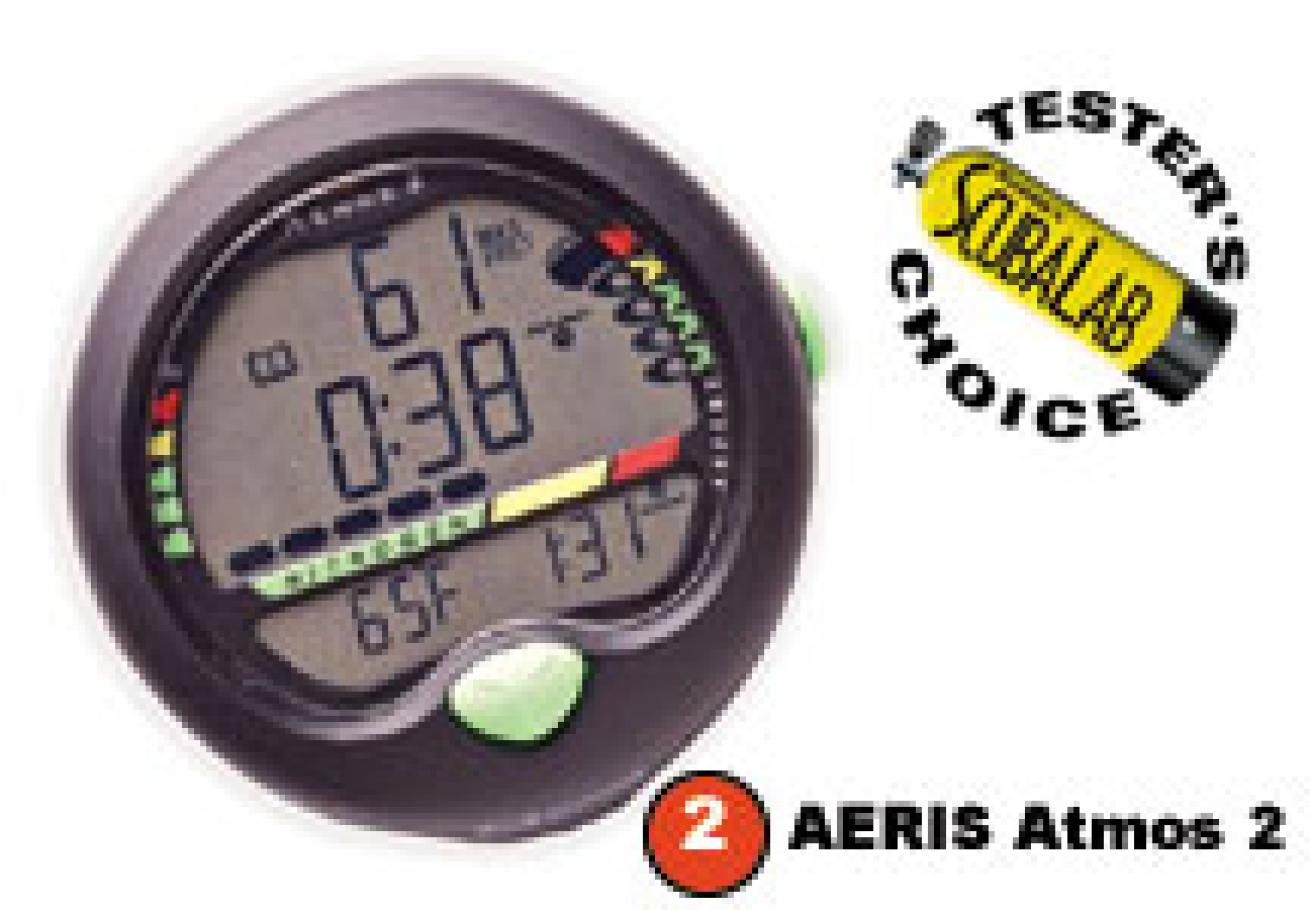
The Atmos 1 and Atmos 2 from Aeris are compact, low-profile computers available in a variety of mounting options. Their screens are large, and data is displayed with big numbers and green-yellow-red bar graphs that make it easy to track nitrogen and oxygen loading as well as ascent rate. Both computers come with replaceable screen guards.
The Atmos 1 is budget-priced and bare bones, providing all the important functions but fewer features like illumination, water temperature and date. The Atmos 2, in contrast, is loaded with features, including temperature and date, both LED light and user-programmable audible alarms, and a backlight that can be set to either three- or seven-second intervals or shut off altogether to conserve battery power.
PRICE: (modules) Atmos 1, $265.95; Atmos 2, $409.95.
WARRANTY: 2 years.
MADE IN: USA.
MOUNTING OPTIONS: Wrist, hose, retractor, console.
NITROX CAPABILITY: Atmos 1, n/a; Atmos 2, 21-50%.
LOGGED DIVES: Atmos 1, 9; Atmos 2, 24.
PC INTERFACE: Atmos 1, n/a; Atmos 2, $159.95.
OWNER'S MANUAL: Very good.
COLOR HIGHLIGHTING: Yes.
MAX DEPTH: Atmos 1, 330 feet; Atmos 2, 399 feet.
VIOLATION LOCKOUT: Gauge mode for 24 hrs.
DESAT/TIME TO FLY: Countdown.
ALARMS: Atmos 1, visual; Atmos 2, visual and audible.
USER CONTROLS: Atmos 1, 1 push button; Atmos 2, 2 push buttons.
BATTERY: 3-volt lithium, 100 to 300 hours, user-replaceable.
3) AERIS Atmos ai

The Atmos ai is the newest air-integrated member of Aeris' Atmos family. It features a large horizontal screen nestled in a small case, a programmable backlight, and both visual and audible alarms. The Atmos ai presents data with huge primary digits (depth blinks continually whether descending or ascending) and good-sized secondary data digits, and makes generous use of graphics and green-yellow-red highlights.
The Atmos ai reads tank pressure to 5,000 psi in increments of 10 psi. Our test unit came with a quick-disconnect high-pressure hose fitting (an extra $60) that enables you to detach the computer from the high-pressure hose for safe storage. There's also a screen guard, a swivel ring on the casing for clipping to a D-ring or retractor, and a place to attach a compass.
PRICE: $739.95.
WARRANTY: 2 years.
MADE IN: USA.
MOUNTING OPTIONS: Console.
NITROX CAPABILITY: 21-50%.
LOGGED DIVES: 24.
PC INTERFACE: $159.95.
OWNER'S MANUAL: Very good.
COLOR HIGHLIGHTING: Yes.
MAX DEPTH: 399 feet.
VIOLATION LOCKOUT: Gauge mode for 24 hrs.
DESAT/TIME TO FLY: Countdown.
ALARMS: Visual and audible.
USER CONTROLS: 2 push buttons.
BATTERY: 3-volt lithium, 100 to 300 hours, user-replaceable.
4) CRESSI-SUB Archimede

A full-featured wrist-mount dive computer (now available in console), Cressi-sub's Archimede uses a central Mode button along with A and B buttons in one of the easiest systems for accessing data, programming functions and activating the five-second backlight. The computer uses three-color bar graphs, although these are relatively narrow. All data digits are extra-large and easy-to-read on a well-designed display that includes "Time," "Plan," "Log" and other prompts at the bottom of the screen to show you what mode you're in. Both audible (disarmable) and visual alarms are provided for critical dive situations.
The Archimede has a logbook function that stores up to 60 dives or 30 hours of diving. There's also a dive history mode that stores up to 599 dives. A Safety Factor adjustment allows you to program an additional level of conservatism into your dive. The Archimede provides a reset button that allows you to clear nitrogen-loading data from the computer's memory.
PRICE: $536 (wrist); $644 (console).
WARRANTY: 1 year.
MADE IN: Japan.
MOUNTING OPTIONS: Wrist, console.
NITROX CAPABILITY: 21-50%.
LOGGED DIVES: 60 dives/30 hrs.
PC INTERFACE: $240.
OWNER'S MANUAL: Very good.
COLOR HIGHLIGHTING: Yes.
MAX DEPTH: 325 feet.
VIOLATION LOCKOUT: Gauge mode for 48 hrs.
DESAT/TIME TO FLY: Countdown.
ALARMS: Visual and audible.
USER CONTROLS: 3 push buttons.
BATTERY: 3-volt lithium, 50 to 150 dives, user-replaceable.
{mospagebreak}5) DACOR Darwin
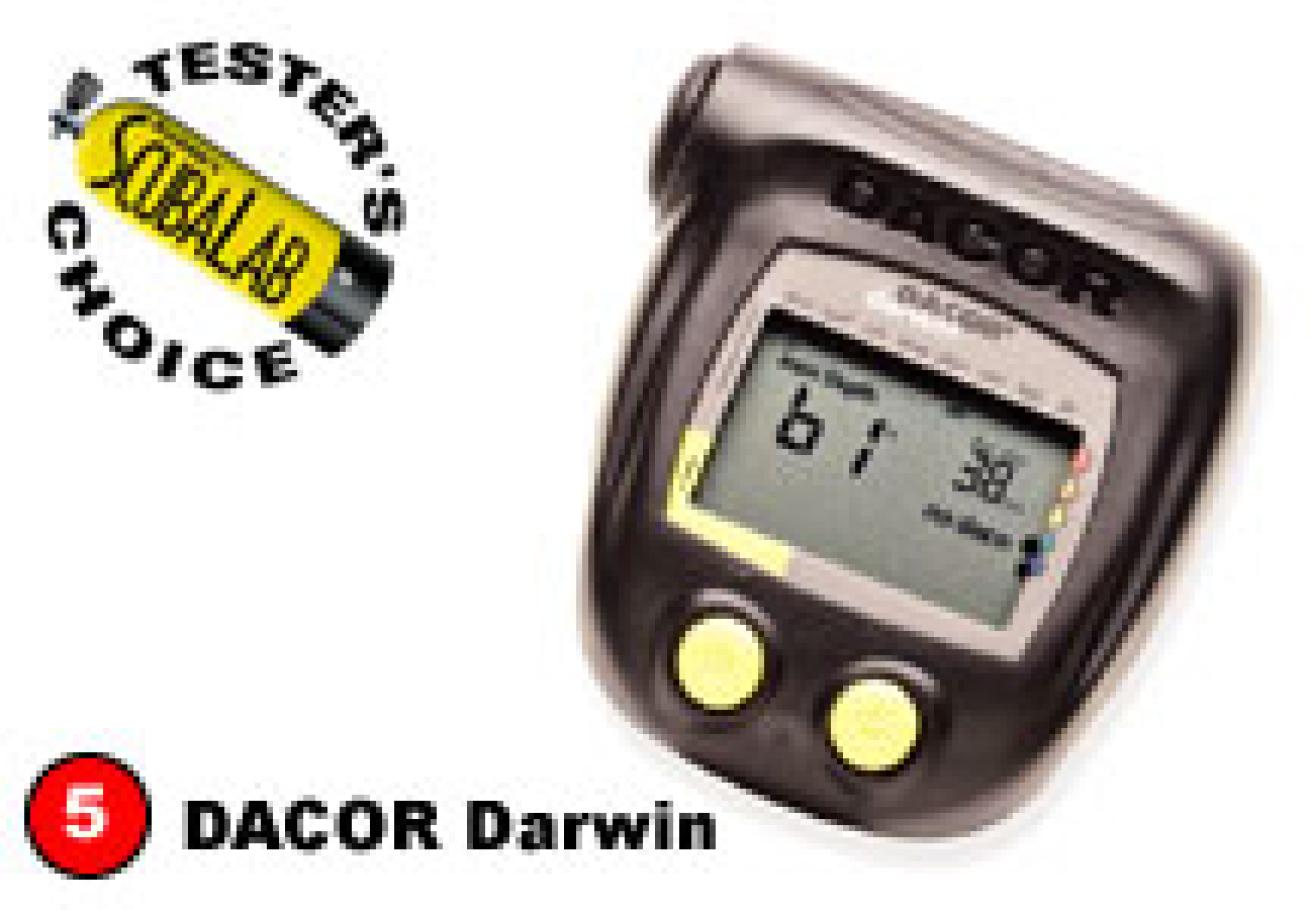
| In a field of user-friendly dive computers, the Dacor Darwin is among the friendliest. Powered by a pair of AAA batteries loaded into an easy-access watertight compartment, the computer offers a backlight that can be programmed either for 15-second intervals or to stay on permanently. This reduces battery life substantially, but with AAA batteries so cheap, so easy to find and so easy to replace without losing memory, why not keep the light on all the time?
The Darwin uses color highlights and has a band along the top of the screen to tell you what mode you're in. Primary data is presented with easy-to-see digits beneath scratchproof mineral glass. Equipped with both visual and audible alarms (audibles can be disabled), you can program in up to three levels of conservatism by adjusting the altitude setting. The computer calculates deco stops down to a depth of 80 feet and includes a function to clear residual nitrogen memory. The optional PC Interface kit uses an infrared linkup.
PRICE: $360 (wrist); $450 (console)
WARRANTY: 2 years.
MADE IN: Italy.
MOUNTING OPTIONS: Wrist, console.
NITROX CAPABILITY: 21-50%.
LOGGED DIVES: 50 dives/50 hrs.
PC INTERFACE: $140.
OWNER'S MANUAL: Good.
COLOR HIGHLIGHTING: Yes
MAX DEPTH: 490 feet.
VIOLATION LOCKOUT: Gauge mode for 24 hrs.
DESAT/TIME TO FLY: Countdown.
ALARMS: Visual and audible.
USER CONTROLS: 2 push buttons.
BATTERY: 2 1.5-volt AAA, 1 year/50 dives, user-replaceable.
6) MARES M1
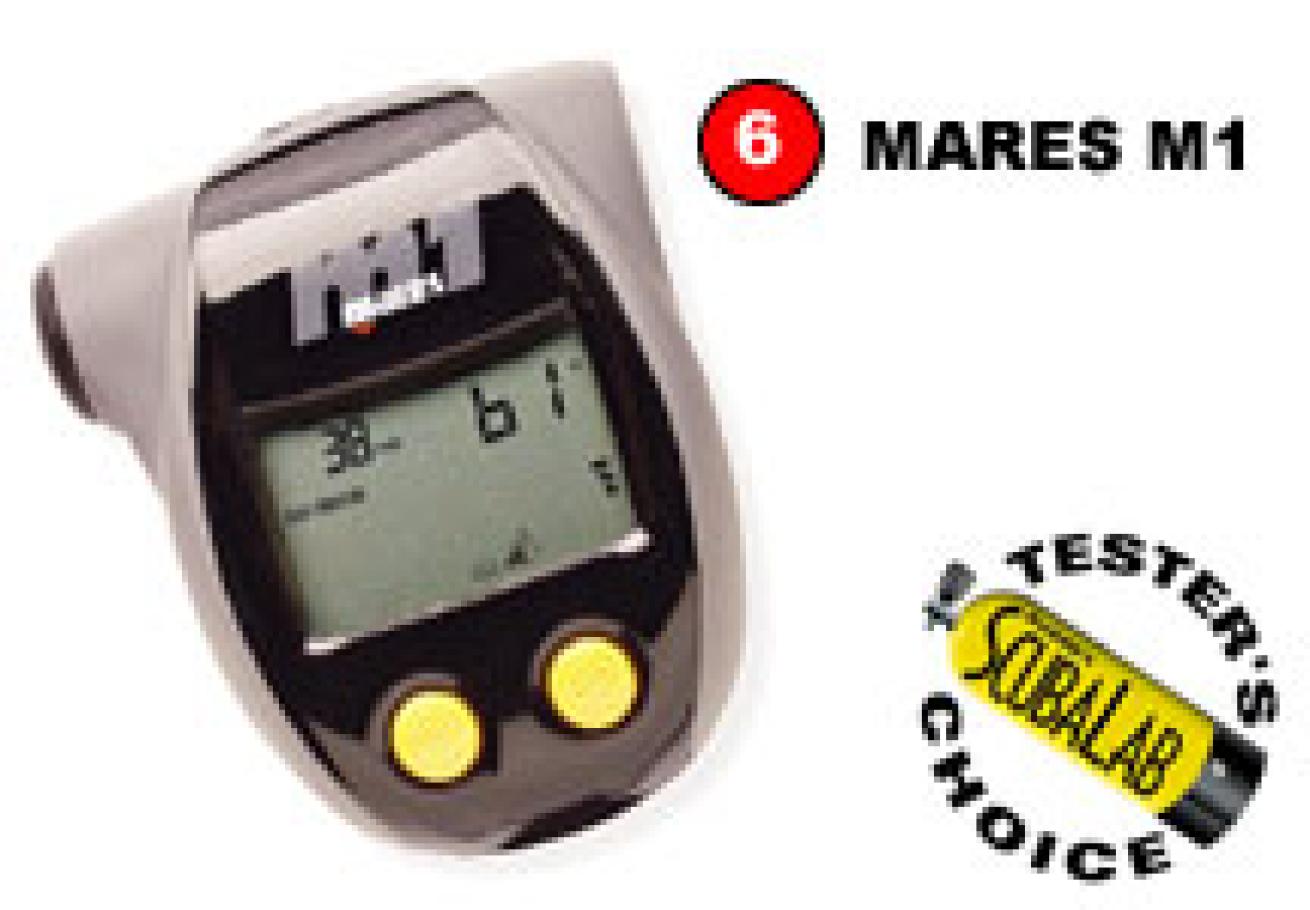
Mares' M1 is one of only two models in this field of dive computers powered by a pair of AAA batteries, located in a watertight compartment that's easy to get to. It's also one of only two computers that enable you to keep the backlight on full-time, as opposed to 15-second intervals. This produces quite a power drain, but AAA batteries are cheap, available just about everywhere and easy to replace without losing memory, so many divers feel the benefits of a full-time light offsets the battery shuffle.
The M1 doesn't use color highlights, and deciphering which mode you're in isn't as easy as on some computers, but primary data is presented clearly beneath scratchproof mineral glass. Equipped with both visual and disarmable audible alarms, you can program in up to three levels of conservatism by adjusting the altitude setting. The computers calculate deco stops down 80 feet and include a function to clear residual nitrogen memory. The optional PC Interface kit use an infrared linkup.
PRICE: $450 (wrist); $495 (console).
WARRANTY: 2 years.
MADE IN: Italy.
MOUNTING OPTIONS: Wrist, console.
NITROX CAPABILITY: 21-50%.
LOGGED DIVES: 50 dives/50 hrs.
PC INTERFACE: $140.
OWNER'S MANUAL: Good.
COLOR HIGHLIGHTING: No.
MAX DEPTH: 490 feet.
VIOLATION LOCKOUT: Gauge mode for 24 hrs.
DESAT/TIME TO FLY: Countdown.
ALARMS: Visual and audible.
USER CONTROLS: 2 push buttons.
BATTERY: 2 1.5-volt AAA, 1 year/50 dives, user-replaceable.
7) OCEANIC Versa & 8) Versa Pro
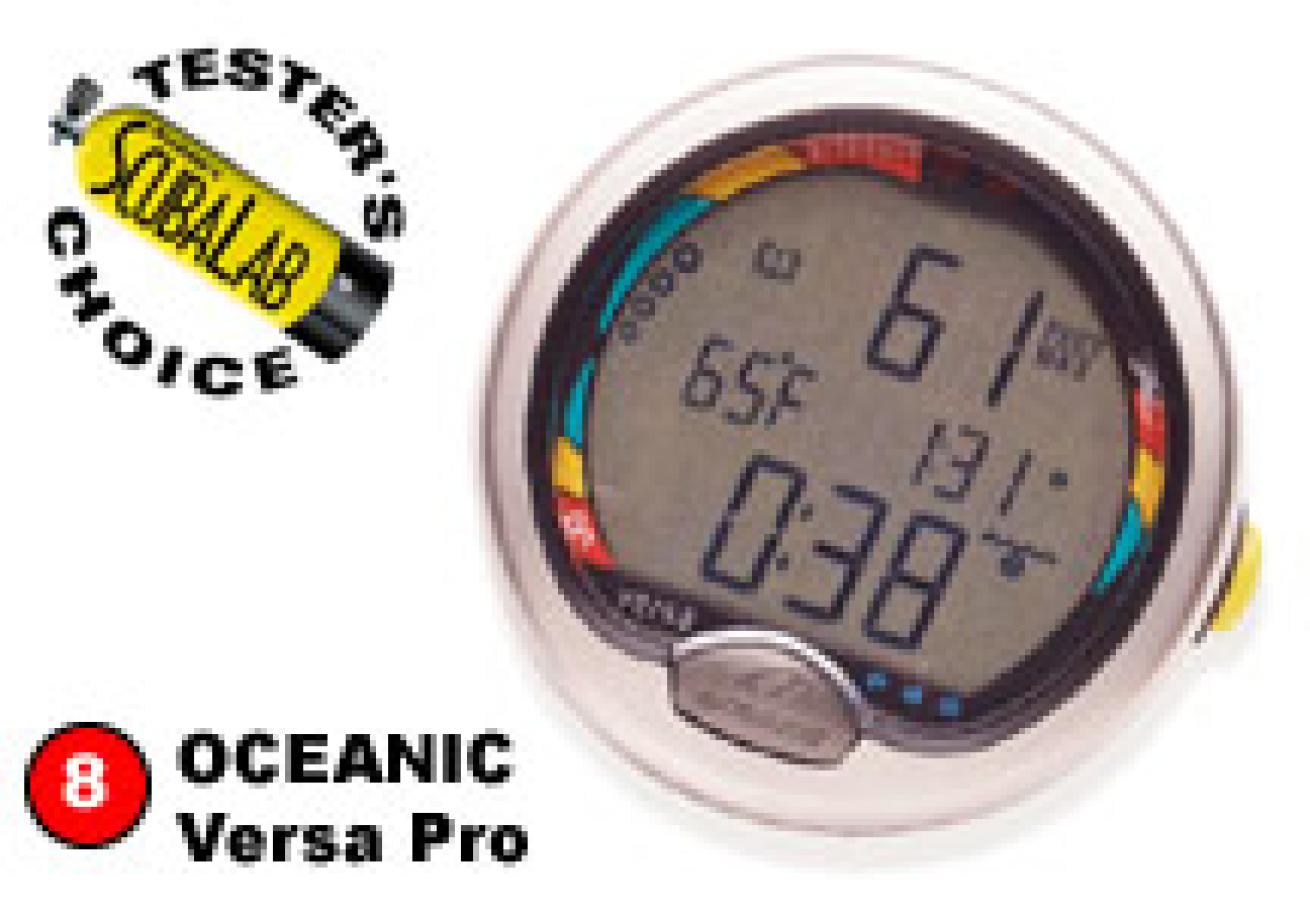
These new computers from Oceanic feature graphic displays, three-color bar graphs and large numbers in compact, low-profile packages. Where the two computers differ is in the details. The economical Versa doesn't offer a backlight or water temperature, nor is it nitrox-capable or PC-downloadable. The Versa Pro has these features plus programmable backlighting and a flashing LED warning light that is synched with disarmable audible alarms.
Use of these computers is very intuitive and both come with outstanding owner's manuals and waterproof quick-reference cards. In the water, screens are easy to see and understand, and secondary data is easily accessible. Replaceable screen covers protect the displays from scratches.
PRICE: (modules) Versa, $285; Versa Pro, $429.
WARRANTY: 2 years.
MADE IN: USA.
MOUNTING OPTIONS: Wrist, hose, console.
NITROX CAPABILITY: Versa, n/a; Versa Pro, 21-50%.
LOGGED DIVES: Versa, 9; Versa Pro, 24.
PC INTERFACE: Versa, n/a; Versa Pro, $169.95.
OWNER'S MANUAL: Very good.
COLOR HIGHLIGHTING: Yes.
MAX DEPTH: 330 feet.
VIOLATION LOCKOUT: Gauge mode for 24 hrs.
DESAT/TIME TO FLY: Countdown.
ALARMS: Versa, visual; Versa Pro, visual and audible.
USER CONTROLS: Versa, 1 push button; Versa Pro, 2 push buttons.
BATTERY: 3-volt lithium, 100 to 300 hours, user-replaceable.
9) OCEANIC Pro Plus 2
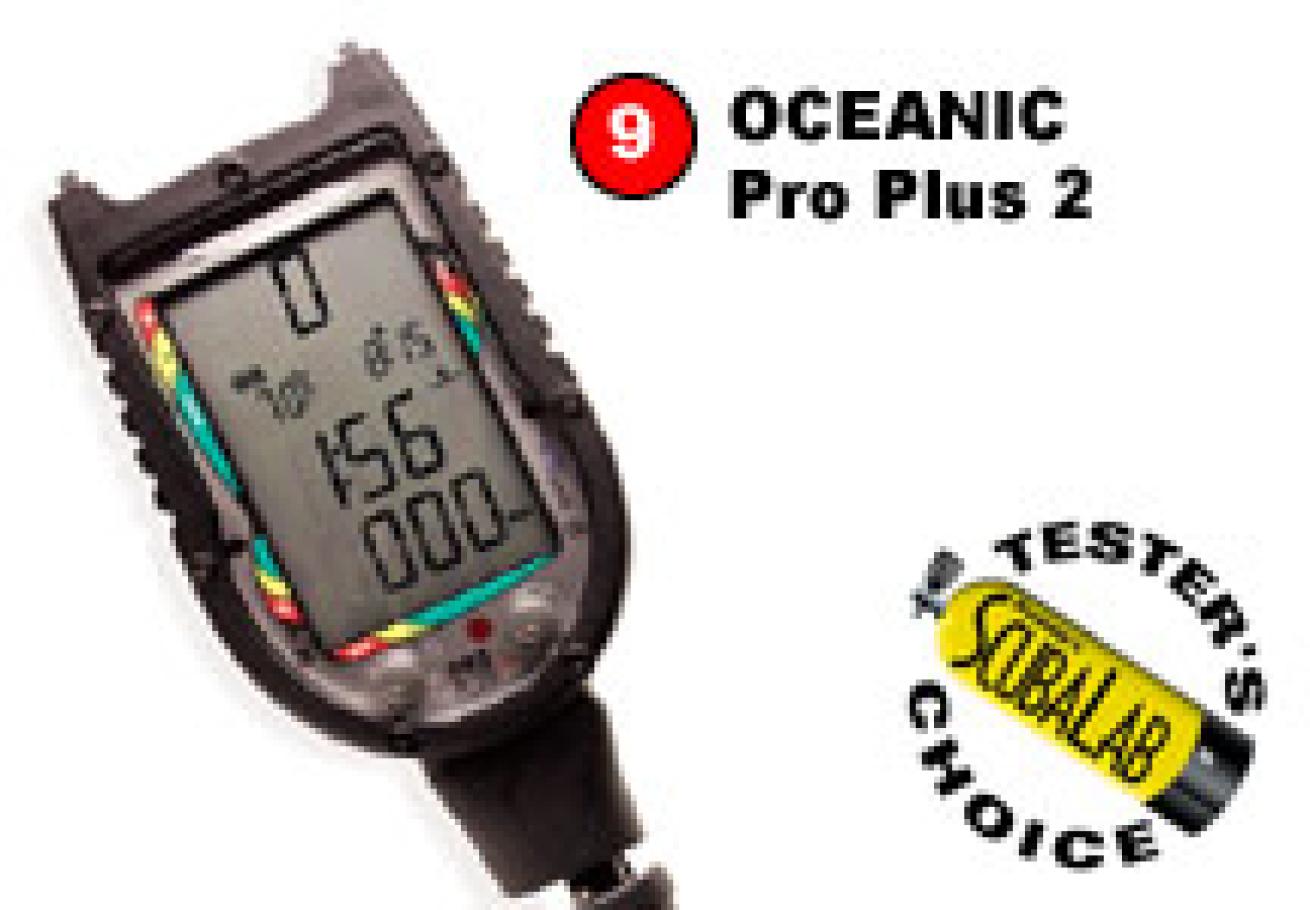
Replacing the Datamax Pro and Datamax Pro Plus, Oceanic's air-integrated Pro Plus 2 is all about big. Big vertical screen, big numbers, big icons, plus lots of color highlights to increase readability. The computer provides both Dive Time Remaining and Air Time Remaining. Tank pressure data is displayed in 10-psi increments up to a maximum of 5,000 psi.
Like all computers in this review, the Pro Plus 2 offers either water or manual activation, plus provides a bevy of both LED light and audible alarms. A time-and-date stamp makes it easy to locate a specific dive from the 24-dive logbook. The backlight is programmable for up to 10 seconds. The Pro Plus 2 is available with an optional quick-disconnect high-pressure hose fitting, in our view a must-have for any console-mounted air-integrated computer.
PRICE: $735.
WARRANTY: 2 years.
MADE IN: USA.
MOUNTING OPTIONS: Console.
NITROX CAPABILITY: 21-50%.
LOGGED DIVES: 24.
PC INTERFACE: $169.95.
OWNER'S MANUAL: Very good.
COLOR HIGHLIGHTING: Yes.
MAX DEPTH: 330 feet.
VIOLATION LOCKOUT: Gauge mode for 24 hrs.
DESAT/TIME TO FLY: Countdown.
ALARMS: Visual and audible.
USER CONTROLS: 2 push buttons.
BATTERY: 3.6-volt 1/2AA, 50 to 300 hrs., user-replaceable.
10) SCUBAPRO/UWATEC Smart Pro & 11) Smart Com
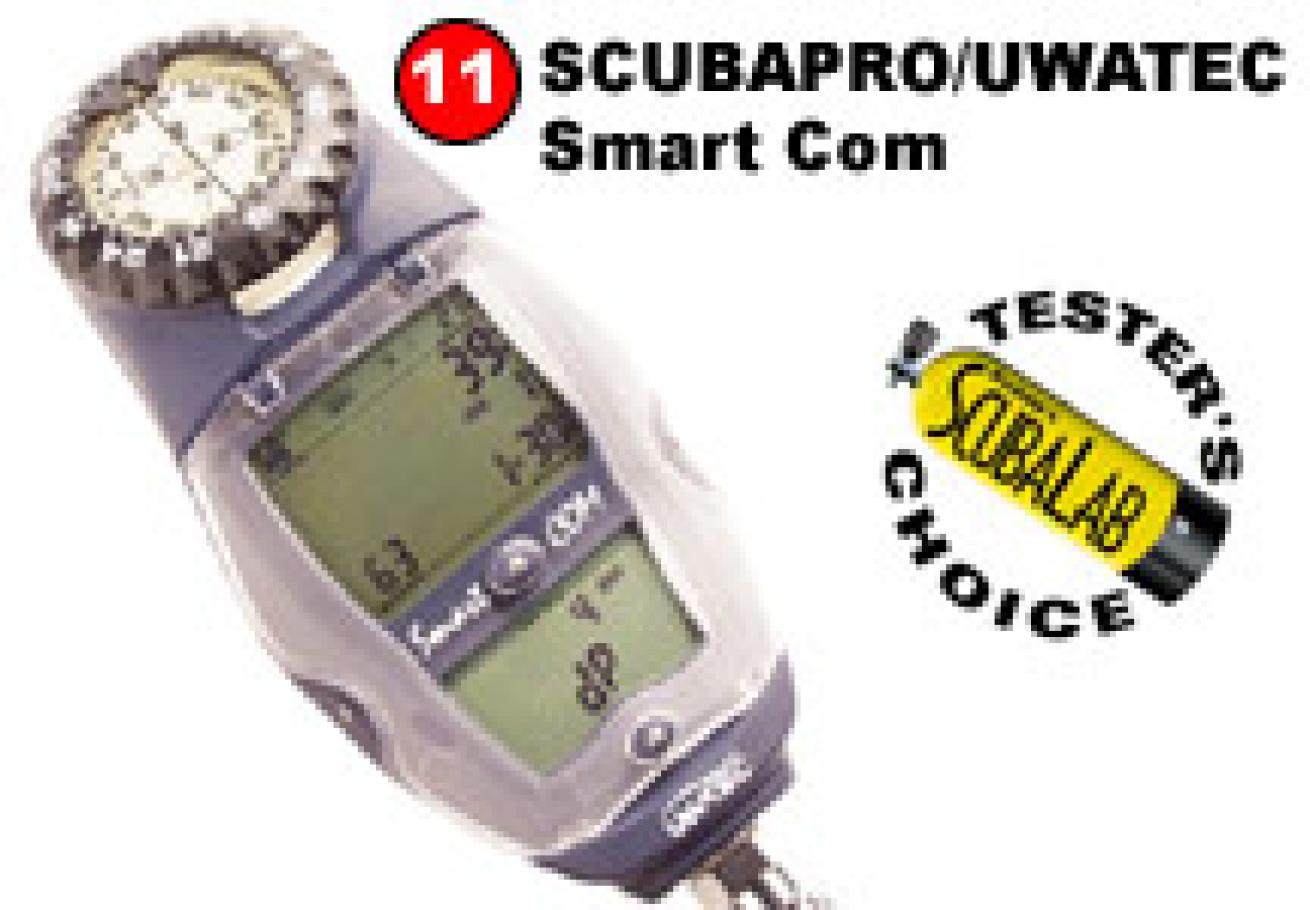
Scubapro's Uwatec Smart Com air-integrated and Smart Pro non-air-integrated computers use a unique algorithm that takes into account actual diver behavior and environmental conditions, and additionally providing the user with the ability to program in six levels of micro-bubble suppression to increase safety. Screens are 35 percent larger than previous generations with larger numbers and icons but no color highlights. Desaturation time and time to fly are calculated instead of using a standard countdown. Replaceable hinged screen covers protect the displays. The Smart Com reads tank pressure to 4,350 psi in one-psi increments and is available with a quick-disconnect hose fitting (about $15 extra). Each computer comes with its own padded storage bag and SmartTrak software that uses an infrared PC interface.
When violated, Smart computers totally lock you out for 24 hours instead of reverting to gauge mode. Backlights take some getting used to. They are activated by pressing the computers' casing, although the exact spot is sometimes difficult to find at depth. Neither computer offers date or time data.
PRICE: Smart Pro, $638 (wrist); $734 (console); Smart Com, $896 (with standard HP hose).
WARRANTY: 2 years.
MADE IN: Switzerland.
MOUNTING OPTIONS: Smart Pro, wrist, console; Smart Com, console.
NITROX CAPABILITY: 21-100%.
LOGGED DIVES: Smart Pro, 100 hours; Smart Com, 50 hours.
PC INTERFACE: Included; infrared port on PC not included.
OWNER'S MANUAL: Fair.
COLOR HIGHLIGHTING: No.
MAX DEPTH: 395 feet.
VIOLATION LOCKOUT: Total for 24 hrs.
DESAT/TIME TO FLY: Calculated.
ALARMS: Visual and audible.
USER CONTROLS: 4 electrical contacts.
BATTERY: Special to Uwatec, 500 to 1,000 dives, factory-replaceable (free lifetime battery).
12) SHERWOOD Wisdom
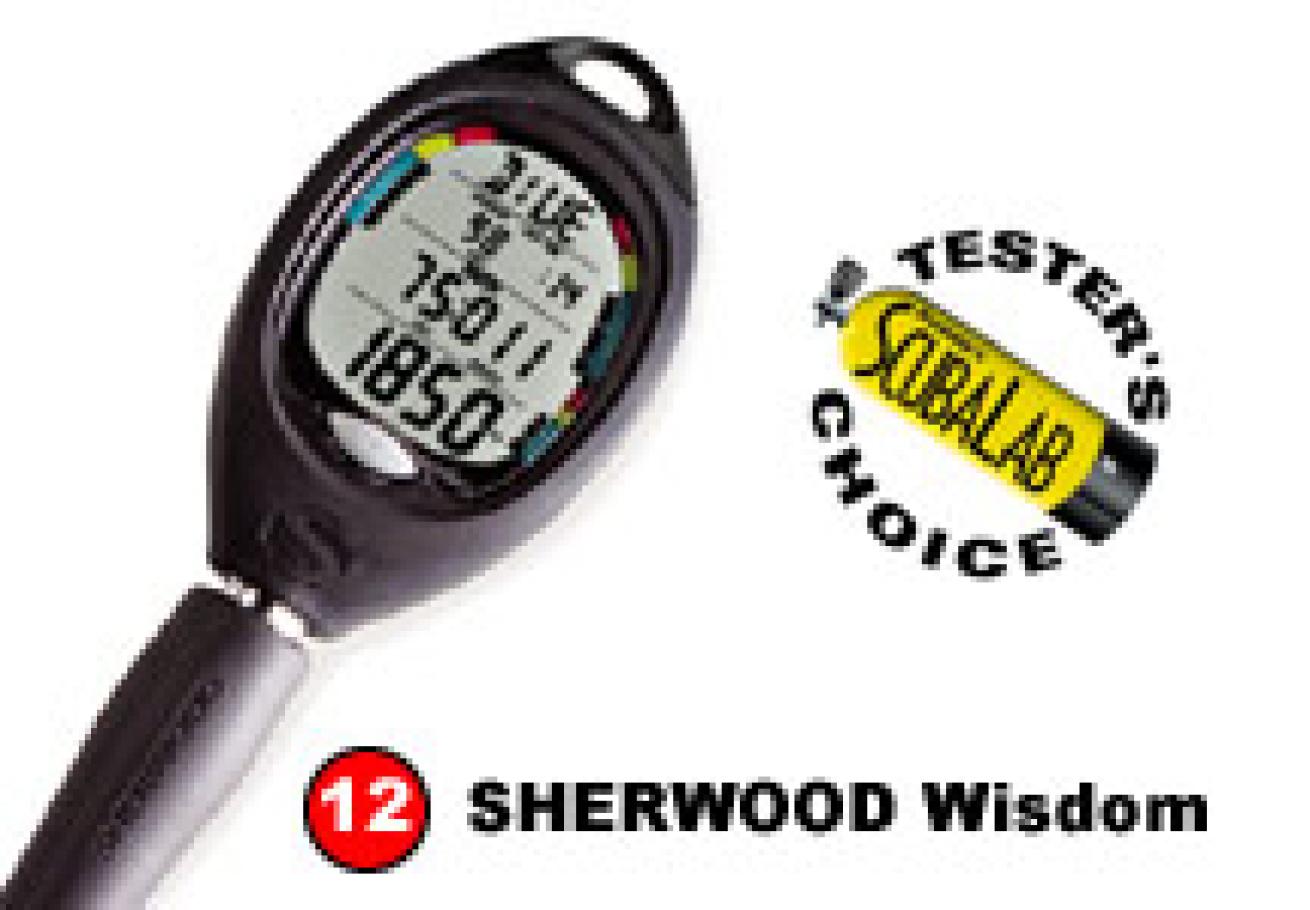
| While not available at the time of testing, we have since had a chance to check out the all-new Wisdom from Sherwood. This is a nifty air-integrated computer with one of the most intuitive displays available. The screen is large and the numbers leap right out at you. Generous use is made of green-yellow-red bar graphs. At the top of the screen the words "Dive," "Log," "Plan," etc. are displayed, eliminating the confusion of trying to figure out what mode you're in.
The Wisdom provides both Dive Time Remaining and Air Time Remaining. Tank pressure is read up to 5,000 psi in 10-psi increments. The backlight can be programmed for up to 10-second intervals and audible alarms can be user-disabled. Deco stops are calculated starting at 60 feet. The Wisdom is available with an optional compass and high-pressure hose quick-disconnect (about $110 extra). A replaceable "face-saver" lens cover protects the screen from scratches.
PRICE: $780.
WARRANTY: 2 years.
MADE IN: USA.
MOUNTING OPTIONS: Console.
NITROX CAPABILITY: 21-50%.
LOGGED DIVES: 50.
PC INTERFACE: $150.
OWNER'S MANUAL: Not available at press time.
COLOR HIGHLIGHTING: Yes.
MAX DEPTH: 399 feet.
VIOLATION LOCKOUT: Gauge mode for 24 hrs.
DESAT/TIME TO FLY: Countdown.
ALARMS: Visual and audible.
USER CONTROLS: 2 push buttons.
BATTERY: 3-volt lithium, 300 to 600 hours, user-replaceable.
13) SUUNTO Vytec
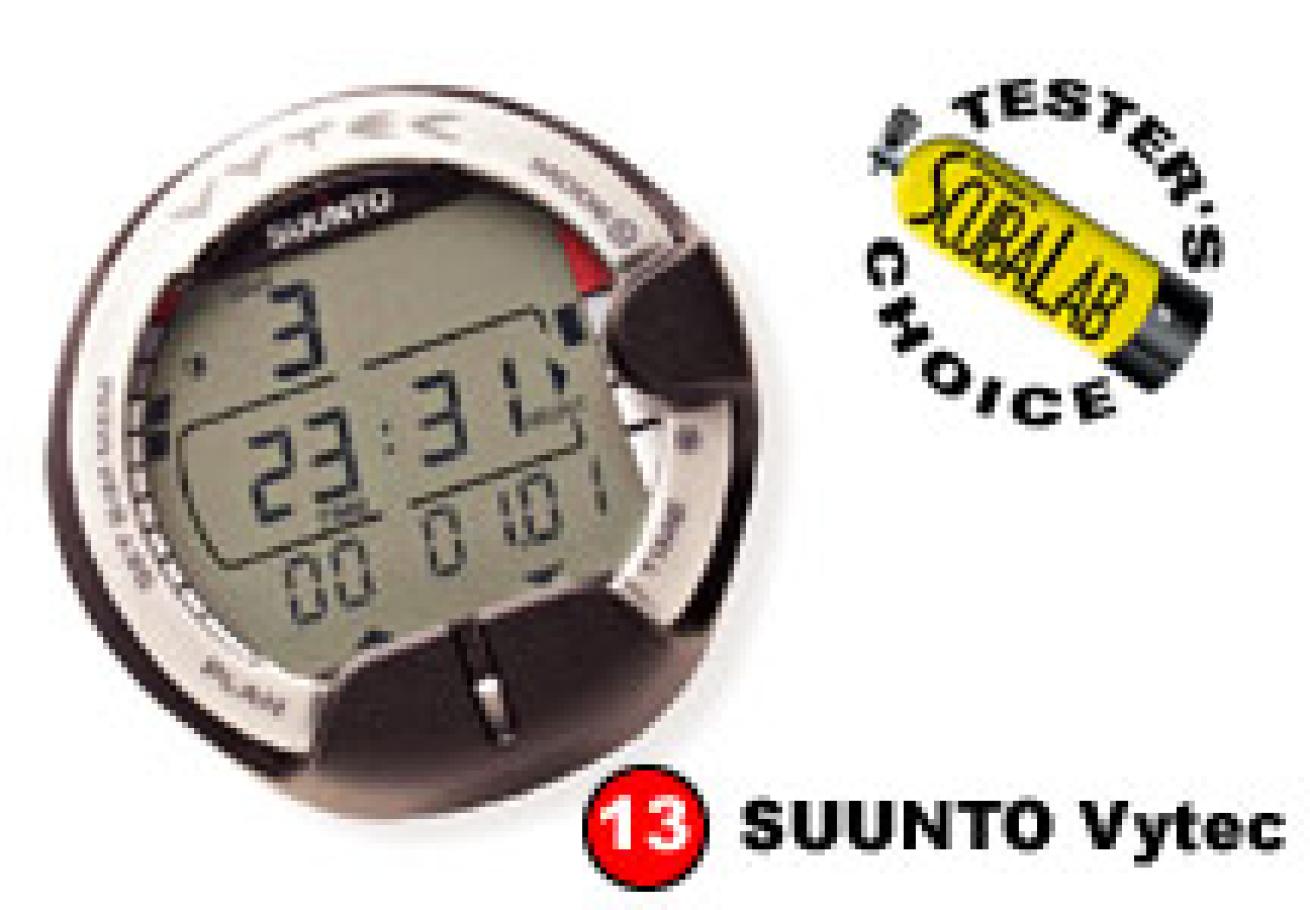
| With the option of "wireless" air integration, a modern RGBM algorithm (Reduced Gradient Bubble Model) that tracks both dissolved and free gas, the ability to switch between up to three nitrox mixes during the course of a dive and a host of altitude settings and personal programming options, Suunto's Vytec is a lot of dive computer in a little package and a favorite among "techies."
The display features easy-to-see numbers and icons and provides word prompts to let you know exactly what mode you're in. Color highlights are limited and can be difficult to see at depth. A replaceable screen cover protects the display. The logbook will hold up to 36 hours of diving, and a lifetime history memory can be accessed via PC linkup. The backlight can be either turned off completely to save batteries or programmed for up to 30 seconds. Using the transmitter, the Vytec reads tank pressure to 5,000 psi at one-psi increments.
PRICE: $1,195 with transmitter, $725 without transmitter.
WARRANTY: 2 years.
MADE IN: Finland.
MOUNTING OPTIONS: Wrist.
NITROX CAPABILITY: 21-99%.
LOGGED DIVES: 36 hrs.
PC INTERFACE: Included.
OWNER'S MANUAL: Very good.
COLOR HIGHLIGHTING: Yes.
MAX DEPTH: 450 feet.
VIOLATION LOCKOUT: Gauge mode for 48 hrs.
DESAT/TIME TO FLY: 12 hrs./calculated.
ALARMS: Visual and audible.
USER CONTROLS: 3 push buttons.
BATTERY: 3-volt lithium, 100 to 400 dives, user-replaceable.
14) TUSA IQ-600
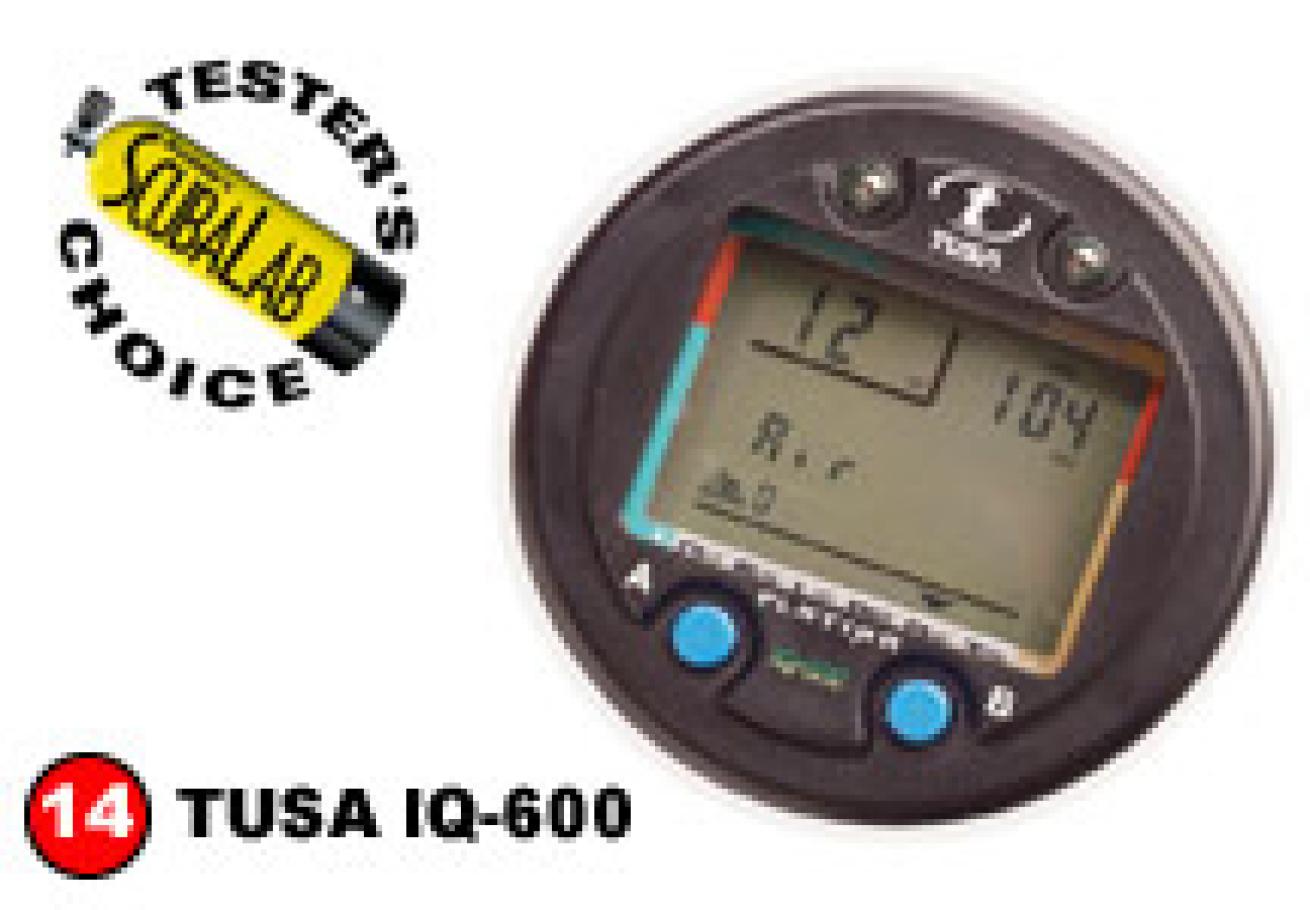
| TUSA's IQ-600 wrist-mount model comes encased in a big shock-resistant rubber casing. The smallish scratch-resistant screen is flanked by two push buttons and two water sensors. The computer uses color highlights and a unique bottom bar that shows you what mode you're in. Data digits are smaller than on most computers, but the all-important depth and no-decompression-limit readouts are displayed at the top of the screen where they can't be confused with other data. The IQ-600 is the only computer in this group with a luminescent face rather than a backlight. Its audible alarms cannot be disarmed.
The IQ-600 can be adjusted so that on a two-tank dive, one tank can be used for air and the other for nitrox. The computer calculates deco stops as deep as 49 feet. A reset button zeros out all nitrogen-loading data. Replacing the battery also erases log data.
PRICE: $468.
WARRANTY: 2 years.
MADE IN: Japan.
MOUNTING OPTIONS: Wrist, console.
NITROX CAPABILITY: 21-50%.
LOGGED DIVES: 10.
PC INTERFACE: $100.
OWNER'S MANUAL: Fair.
COLOR HIGHLIGHTING: Yes.
MAX DEPTH: 328 feet.
VIOLATION LOCKOUT: Total for 24 hrs.
DESAT/TIME TO FLY: Countdown.
ALARMS: Visual and audible.
USER CONTROLS: 2 push buttons.
BATTERY: 3-volt lithium, 2 years, user-replaceable.



